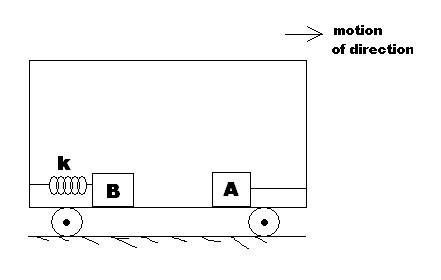n e 1 ?
Fig shows 2 identical blocks of mass m kept on a smooth floor. Block A is connected with a just straight string and block B is connected to rear wall with a relaxed spring. Assume that the floor of the car is smooth and exerts no horizontal forces on the ball. Mark the correct statements.
[a] When train moves with constant velocity there is no force either in string or spring.
[b) When train speedsup strings get taut and spring is compressed such that the force exerted by each on respective blocks is same.
[c] When train slows down block A moves towards the wall.
[d] When train slows down resultant force on block A is non zero in ground frame .
-
UP 0 DOWN 0 0 14

14 Answers
(A) Let's assume the train starts off from a station. It then moves with constant velocity. All horizontal forces are then balanced. So I don't think the blocks will move from their positions. They are moving with the train at the same constant velocity, if viewed from outside-train frame, and inside it as well as an observer would not feel any effect of velocity(humans are accelerometers, they feel only changes in velocity). Hence this is correct.
(B) Okay, now the train wants to speed up to reach another station quickly. It comes out of its constant-velocity state by application of some acceleration or force F.
F is in the right direction. So pseudo forces would apply on the objects in the train toward the opposite direction, with same magnitude F.
For block B, F = kx
For block A, F = T
Both have same magnitudes and directions. I assume you meant magnitudes. So this is correct.
(C) When train slows down a net force applies on the train towards the left. Hence a pseudo force pulls the block towards the wall. This is correct.
Not sure about (D)...will check later, am having lunch now.
i m not getting how a is true ,
i mean when they are saying that the train is moving with vel v , then does it mean that A and B are also moving with v ?? if yes then a is true, but if it doesnt necessary imply that then how is a true ?
The train as a whole is moving with a velocity v. If you look from inside the train, everything is stationary because you are moving with the same constant velocity. From an outside-frame, the train is moving as a whole.
but pritish thats wat my question is , if it is so then how is it possible ?? wat is making the block A move ??
It depends on the frame of reference. When the train moves with constant velocity, inside the train you think everything's stationary. In a frame outside the train, the block is moving with velocity v wrt your frame(if you're stationary).
If you're talking about the case when the train is accelerating, it's Newton's 3rd Law, innit? An equal and opposite (pseudo) force applies on the block to maintain that state of inertia.
Well, I'm not so proficient in this. So wait for someone else's reply.
Pritish u r already assuming that the block is also moving with the train .
See consider a situation where there r no strings and springs. The floor is smooth. Now the train starts moving with a constant velocity. The train cannot exert any force on the block in the direction of motion. So it is as good as the blcok is outside the train. So why on earth will the block move ??
If my above point is correct, then there has to be tension in the string , since after some time string will become taut
I didn't assume it was already moving. It doesn't require strings or springs to move. Here it depends on the frame of reference. Inside the train the blocks remain stationary from your point of view. Outside the train the block moves with velocity v!!
Tabse toh yahi kehne ki koshish kar raha hun...frame of reference babua!
see pritish wat u r telling is absolutely true , but only if it is given that the blocks are also moving with velocity v .
btw ans is acd
i now get the explanation for the options being a c and d!!!
a is sure by fbd!!
b is ruled out due to the period when the spring gets compressed, the force is not equal to tension in string
c is true is true, because the block experiences a pseudo force in the right direction
qwerty
Think it like this.
Initially when train starts moving( it cannot move with the constant speed), it has to accelerate.
So Initially there will be a tension in the string.
Now when it starts to move with constant velocity, think what will happen?
sir i thought it that way , but wat about the spring then ??? It would be a different case for the spring na ?